Lizards are some of the most diverse and fascinating creatures on our planet, found everywhere from tropical rainforests to dry deserts. At Blue Planet Aquarium, we are home to an incredible range of lizards, including the gila monster, panther chameleon, Chinese crocodile lizard, yellow-headed gecko and giant day gecko. These reptiles are usually towards the top of our visitors’ must-see lists, and there are tonnes of reasons why.
In this blog, we’ll look at the different families of lizards, uncover some must-know facts, and shine a light on the spectacular species you can discover at Blue Planet Aquarium.
What is a lizard?
Lizards are reptiles belonging to the order Squamata, which also includes snakes. They are not amphibians, despite sometimes being mistaken for them, as they do not need to live in water to survive.
Instead, they have scaly, waterproof skin that allows them to thrive on land. Another common misconception is that crocodiles are lizards. Although they may look similar and spotting the differences is difficult, crocodiles belong to a separate order known as Crocodilia.
There are thousands of lizard species worldwide, and these are grouped into different families. One of the largest is the Gekkonidae, or geckos, which are instantly recognisable for their sticky toepads that allow them to climb even smooth surfaces. This group includes the yellow-headed day gecko (Phelsuma klemmeri) and the Madagascar giant day gecko (Phelsuma grandis), both of which can be found here at Blue Planet Aquarium.
The Iguanidae family contains iguanas – typically large, plant-eating reptiles – and includes species such as the lau banded iguana.
Another group is the Agamidae, often known as agamids, which are widespread across Australia, southern Asia, and Africa, and include bearded dragons, the frilled-neck lizard (Chlamydosaurus kingii), and water dragons (Intellagama lesueurii).
The Scincidae, or skinks, also known as the largest family of lizards, are usually small with smooth, shiny scales and make their homes underground by burrowing like a hamster. There are over 1,500 recognised species of skinks, which include the rainbow skink (Lampropholis delicata), the fire skink (Lepidothyris fernandi), and the blue-tailed skink (Cryptoblepharus egeriae).
The Varanidae family contains the famous monitor lizards, including the formidable komodo dragon (Varanus komodoensis), the largest living lizard in the world.
Finally, there’s the Chamaeleonidae, the chameleon family, best known for their colour-changing abilities and independently moving eyes.
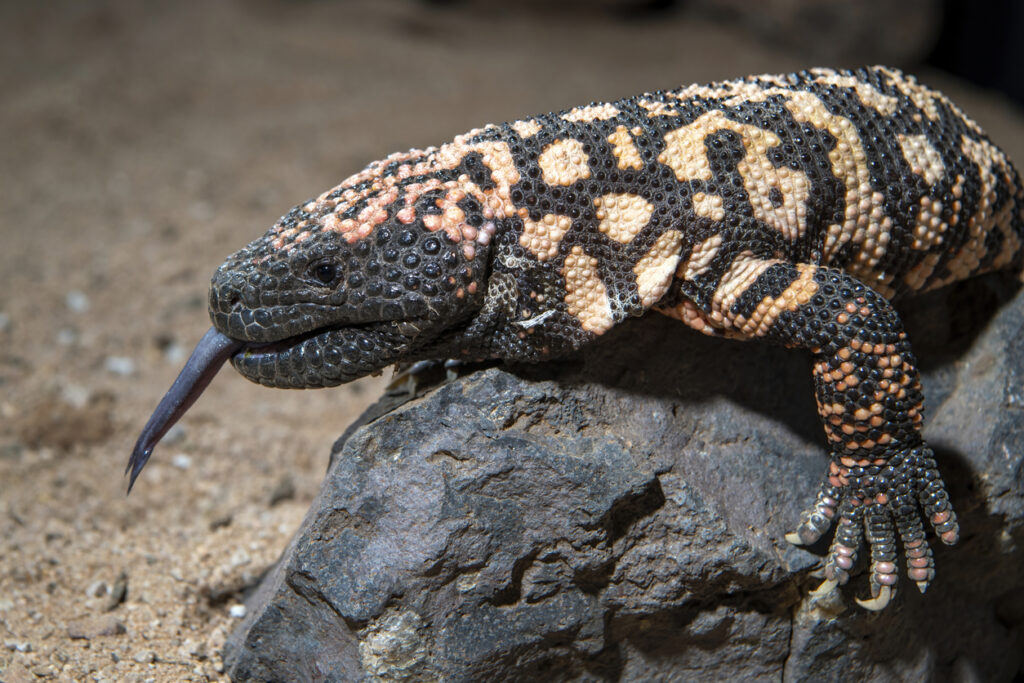
Must-know facts about lizards
There are 5,000+ species of lizards in the world
Lizards are an incredibly diverse group, with more than 5000 species living across the globe. They are found everywhere apart from Antarctica, thriving in environments that range from dense tropical rainforests to barren deserts. This huge variety means lizards come in many shapes, sizes and colours, with unique adaptations to fit their environment.
Lizards have been around for over 200 million years
Fossil records show that lizards first appeared during the time of the dinosaurs. Over millions of years, they have survived major environmental changes and mass extinctions, gradually evolving into the incredibly diverse species that exist today.
Some lizards are found in the UK
Although most people associate lizards with warmer parts of the world, we do have species living in the UK. The common lizard (Zootoca vivipara), sand lizard (Lacerta agilis), and slow worm (Anguis fragilis) are all native to Britain. Despite its name, the slow worm is not a snake; it’s actually a legless lizard.
Almost all lizards are cold-blooded
Like other reptiles, lizards are ectothermic, or cold-blooded, which means they depend on external sources of heat to regulate their body temperature. This behaviour explains why you often see lizards basking in the sun.
Being cold-blooded is energy efficient and helps them survive in challenging conditions. However, there are rare exceptions: the Argentine black and white tegu (Salvator merianae) can generate body heat during the breeding season, making it partially warm-blooded.
The komodo dragon is the largest lizard on Earth
The mighty komodo dragon (Varanus komodoensis) holds the title of the largest living lizard. Growing up to three metres long and weighing up to 135kg, this fearsome reptile is native to a few Indonesian islands and is an apex predator in its environment.
The smallest lizard is the Jaragua dwarf gecko
At the other end of the scale is the brookesia nana, which measures just 13.5 millimetres in length. This tiny chameleon, found in northern Madagascar, is so small it can perch comfortably on a fingertip. How adorable!
The gila monster is one of the most venomous lizards
The gila monster (Heloderma suspectum) is one of only a few lizards in the world capable of producing venom. It delivers the toxin through grooves in its teeth when it bites. Despite their fearsome reputation, gila monsters are slow-moving and spend most of their lives underground, only emerging occasionally to feed.
Some species of lizard can fly
Certain lizards, such as those belonging to the Draco genus, are capable of gliding between trees. They achieve this using wing-like flaps of skin stretched along their ribs, which allow them to drift gracefully through the air.
Lizards have a varied diet
So, what do lizards eat? The answer really depends on the species. Many are insectivores, eating crickets, flies, and other small invertebrates. Others, such as iguanas, are herbivores that feed on leaves and fruit. Some lizards, like monitor lizards, are carnivorous and prey on small animals, birds, and even carrion. This variety in diet reflects the adaptability of lizards.
Some lizards shed their tail as a form of defence
Many lizard species can shed their tails in a process called autotomy. If threatened by a predator, the lizard’s tail will detach and continue to wriggle, distracting the predator while the lizard escapes. Over time, the tail can grow back, although it usually looks slightly different from the original.
Lizards may have 3 eyes
Some lizards, such as iguanas, have a parietal eye, often described as a “third eye.” Located on top of the head, this light-sensitive organ does not form images but helps the lizard detect changes in light and movement, which can be useful for spotting predators.
Chameleons, anoles and geckos can change colours
Many lizards can change their colouring, and not just for camouflage. Chameleons, anoles and some geckos alter their colours to communicate mood, regulate body temperature, or signal to potential mates.
Lizards lay eggs to reproduce
Around 90% of lizard species reproduce by laying eggs, which are typically small, white, and soft-shelled. Some species bury their eggs in soil or sand, while others may incubate them to ensure they hatch successfully. Some lizards are ovoviviparous, with eggs that develop and hatch inside the mother, so the young are born live, such as the Jackson’s chameleon (Trioceros jacksonii).
Unfortunately, numerous species of lizards are at risk of becoming endangered
Despite their adaptability, many lizards are now considered vulnerable or endangered. Habitat loss, climate change, invasive predators, and the illegal pet trade all threaten their survival. Without conservation efforts, some species face the risk of extinction in the near future.
See lizards at Blue Planet Aquarium
If you would like to see these amazing creatures in person, without having to venture through rainforests or tropical islands, Blue Planet Aquarium is home to a large collection of lizards, from small species to truly impressive ones.
Panther chameleon
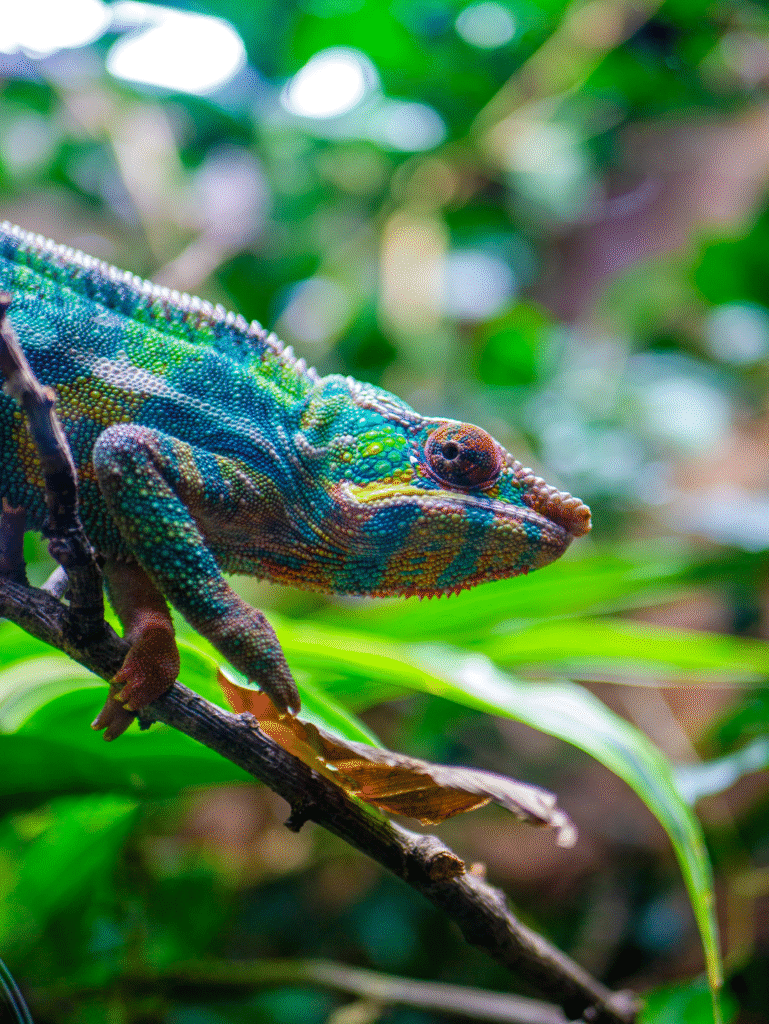
The panther chameleon (Furcifer pardalis) is one of our most striking residents. Native to Madagascar, it is famous for its bright colours and long, sticky tongue that can extend up to twice the length of its body to catch prey.
Madagascar giant day gecko
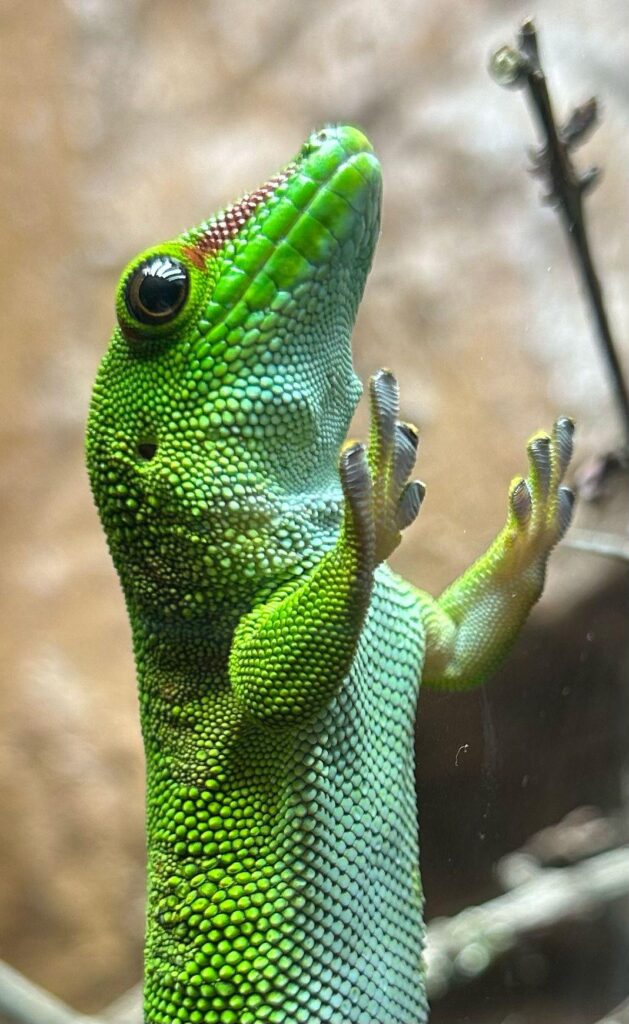
Despite its small size, the yellow-headed day gecko (Phelsuma klemmeri) is no less remarkable than its larger cousins. Heralding from Madagascar, with its bright colouring and adhesive toepads, it can scale bamboo and other plants effortlessly.
Lau banded iguana
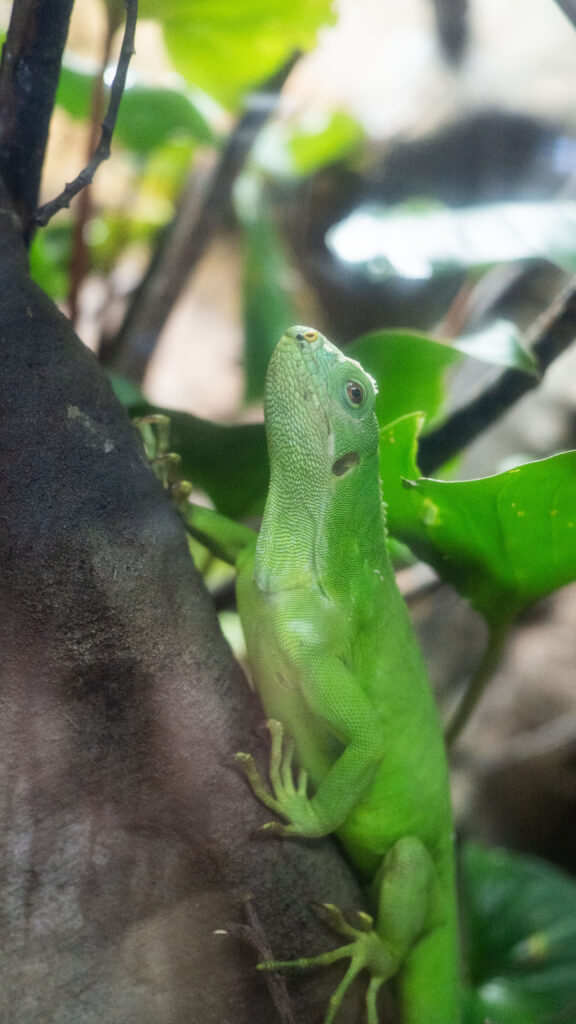
The Lau banded iguana (Brachylophus fasciatus) comes from the Lau Islands. Males are bright green with white stripes, while females are a more uniform shade of green. Their appearance makes them easy to spot in their natural rainforest habitat.
Gila monster
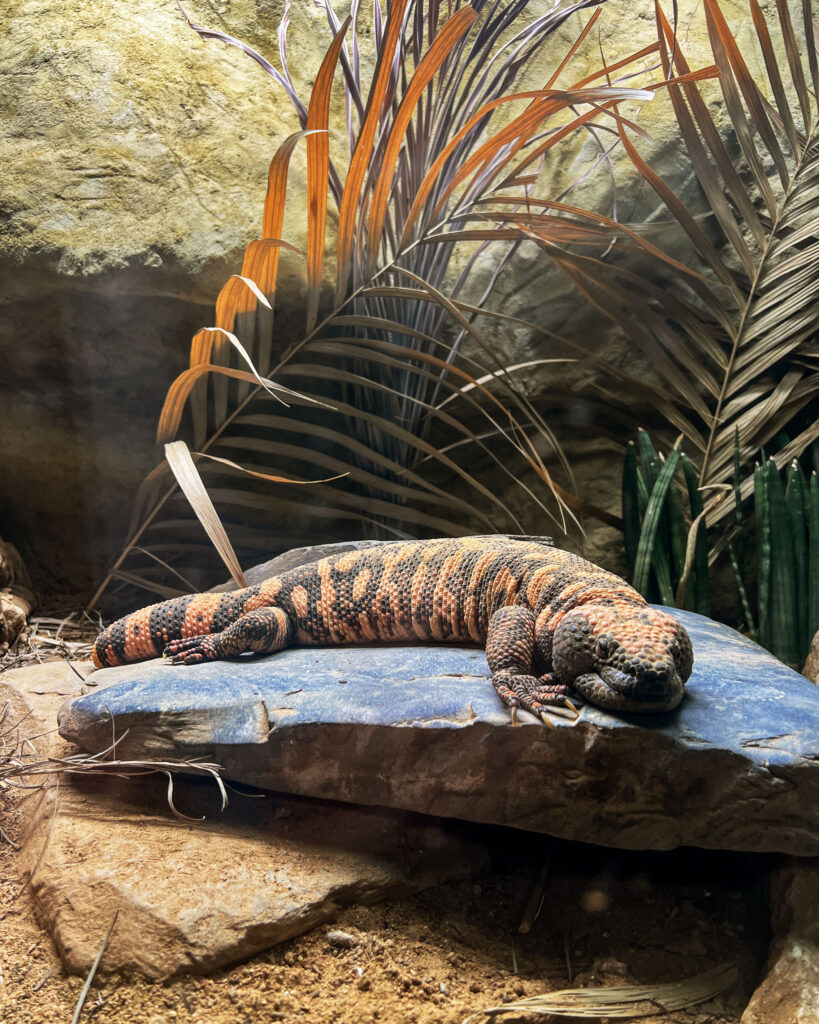
At our Venom Exhibit, you can meet the gila monster, one of the very few venomous lizards on Earth. Pronounced “hee-luh,” not “gi-ya,” or “gi-la,” this reptile spends over 90% of its life underground and only emerges to hunt or bask in the sun. Like we mentioned, the Gila monster can produce a nasty, venomous bite if threatened – so stay back!
Jamaican turquoise anole

The Jamaican turquoise anole (Anolis grahami) is another spectacular species on display. Its emerald-green body shimmers with deep blue tones across its legs and trunk, making it one of the most colourful lizards you will ever see.
Chinese crocodile lizard
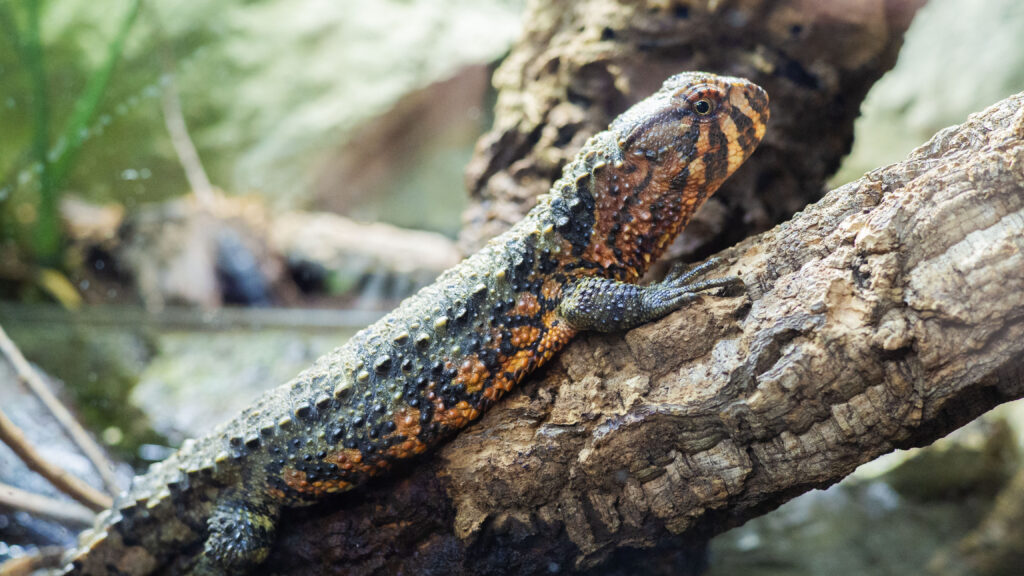
Finally, the Chinese crocodile lizard (Shinisaurus crocodilurus), found in our Flooded Forest exhibit, has a striking, crocodile-like appearance. It is semi-aquatic, diving into the water to escape predators and using its powerful tail to propel itself. This species is also diurnal, meaning it is most active during the day.
Lizards are among the most varied and adaptable reptiles in the world, ranging from tiny geckos to the mighty Komodo dragon.
We’re proud to showcase a number of these remarkable creatures, giving visitors the chance to learn about their behaviour, habitats, and importance in the natural world.
If you’d like to take part in the valuable conservation of lizards across the world, book your tickets to Blue Planet Aquarium today!
